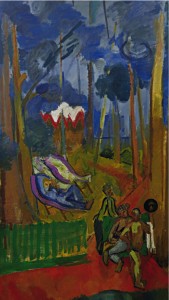Zusman was a subtle and intelligent artist, one who could have been sure of anything and anyone but himself. In 1968, when he had already become a mature master, he put the following entry in his diary: “Of all the ‘talents’ that I have been endowed with, the gift of an artist is the most modest, but, from force of circumstances, it is an artist that I have become, and I have been forced to speak the language that I find particularly difficult to use.”
It is hard to say what language was the hardest for Zusman to use but it is a fact that he was just as brilliant with a pen in his hand as with a brush. It is worth citing one more passage from his notes: “It is a possible paradox that where art is free, too free, it will become weak, degenerate, degrade because of the absence of obstacles, but that fifty years of oppression, brutalization, clampdowns bring genuine art into existence. Because only something genuine and resilient, able to withstand pressures will be able to somehow stay around, to survive. Who will be able to get through this terrible filter? Only the strong. Everything weaker will stay inside the filter. It’s interesting, very interesting how our descendants, “digging through today’s petrified shit” [except from a poem by Vladimir
Mayakovsky], will be finding precious bullion, evidence of genuine human art.” Has this question been answered definitively? It has not, and it won’t be soon.
The Russian art of the twenties and early thirties was marked by the coexistence of various associations of artists and rivalry between them. Alexander Labas was a founding member of the Society for Easel Painting (OST), Leonid Zusman had some of his works included in the fourth OST exhibition in 1929, and Rostislav Barto and Boris Golopolosov were members of the Painters Guild. Alexander Rusakov and his wife Tatyana Kuperwasser were members of the Artists’ Circle in Leningrad, a group that set itself the task of creating the “style of the epoch” and obviously carried it out. Eighty years have gone by, and today, speaking about particularly memorable art events of the twenties, we mention the names of Artists’ Circle members and works by them, including Rusakov’s “On the Beach” and Kuperwasser’s “In the Street,” a poignant piece that pictures a scene from the era of Mikhail Zoshchenko and Daniil Harms.



